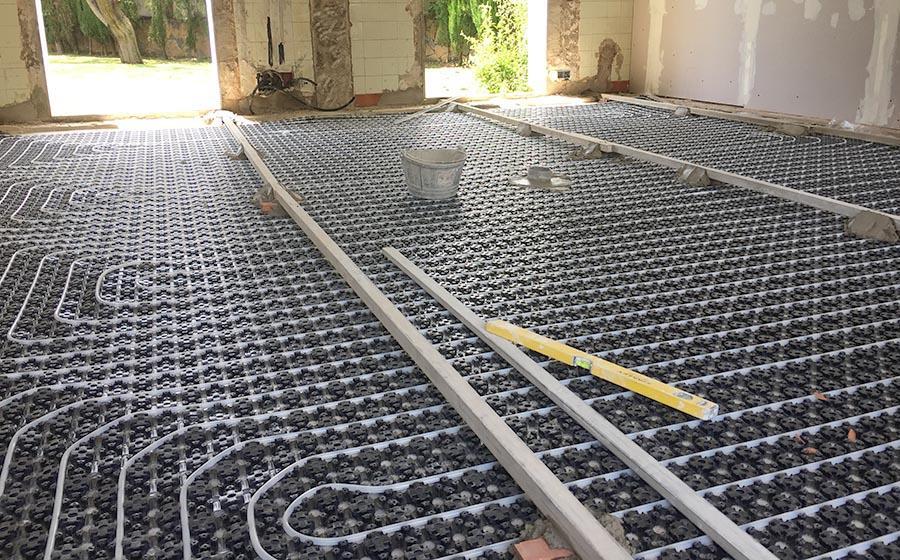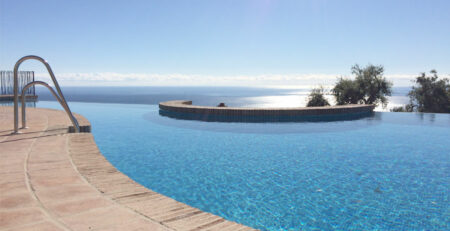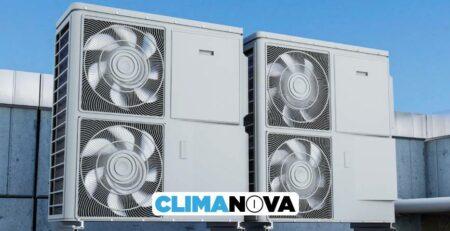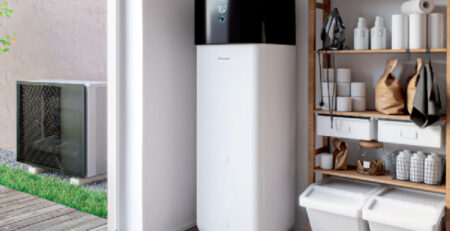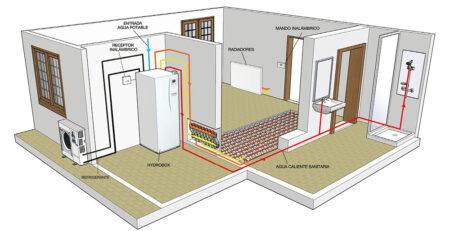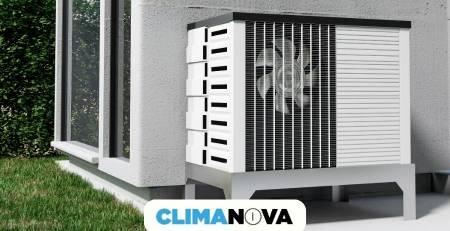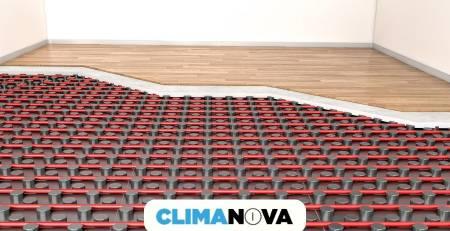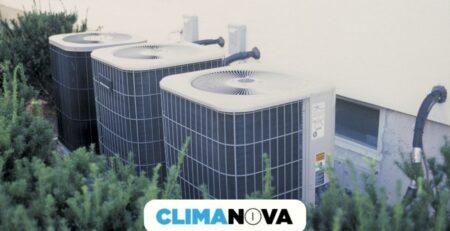Heat pump for underfloor heating is one of the best heating systems for the home. It allows great savings in electricity consumption and provides greater comfort. Below we explain what aerothermal energy is and the advantages when it is combined with a radiant floor system.
What is Air Source Heat Pump
The air source heat pump allows to obtain thermal energy from the air to heat a house or to obtain hot water. It is available 24 hours a day, is free and is efficient even in adverse weather conditions. This technology uses a highly efficient heat pump, capable of extracting heat from the outside air and transferring it to the indoor units.
They are air-water type systems that transmit the heat from the air to the water used by the air conditioning system. It is not necessary to have heat outside, these systems are designed to be able to extract heat even in winter weather conditions.
The heat pump system consists of at least one outdoor unit to capture heat from the air. Inside there must also be at least one hydraulic module that transmits the heat to the heating circuit.
If you are concerned about the environment, our advice is to opt for aerothermal energy. It is powered by renewable energy and helps to reduce electricity consumption. To give you a better idea, 25% of the energy it produces comes from electricity consumption (to power the compressor and the fan), the remaining 75% is obtained from the air.
Even the World Health Organization recommends it for being more ecological, efficient and healthy.
For homes and buildings with central heating systems, shifting from coal, diesel and fuel oil combustion to natural gas, LPG, and geothermal or electric heat-pump technology can reduce energy costs, as well as climate and health impacts related to outdoor air pollution exposures.
They are ideal solutions for both new and existing single-family homes that have space for installation. Unlike other systems, it requires practically no maintenance, is very safe, efficient, silent and does not require a chimney.
What is underfloor heating
The thermodynamics of underfloor heating is very simple. It consists of a system of pipes that will remain under the floor and where the water we have heated will circulate thanks to the heat pump system. The pipe circuit is connected to a box of collectors where the regulation and flow control elements are located. This will allow us to control the temperature of each room independently.
The installation is not excessively complex, but it is necessary that it is carried out by professionals. It is essential to respect the regulations to avoid problems that could require costly solutions. For example, insulation is important to avoid humidity, as well as to prevent the expansion of the floor so that it does not affect the walls.
The pipe circuit is covered with mortar, once it has dried the desired coating can be placed. Stoneware is one of the materials that best combines with underfloor heating as it has excellent heat transmission. If you prefer a parquet floor, most are currently valid, but it is better to discuss this with the seller before choosing.
Once the system is running, it will gradually heat the floor in the room until it reaches the desired temperature. The floor temperature can reach 29°, which is the limit set by current regulations.
To regulate the temperature of the underfloor heating, we install control panels that are very easy to configure. In addition, technological advances now make it possible to control some of these systems from a mobile phone or tablet through very intuitive applications. In short, the opinions of our customers about the radiant floor are very positive.
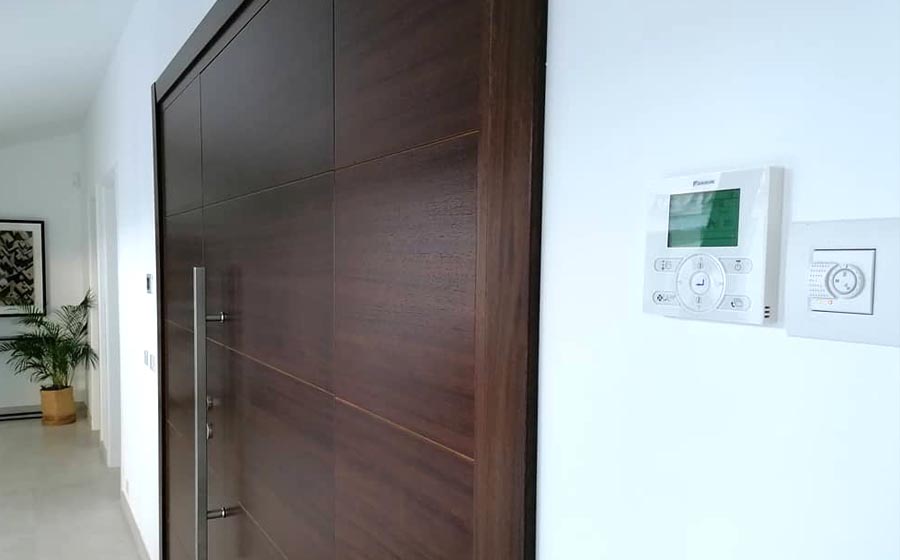
Advantages of heat pump for underfloor heating
Unlike other heating systems, with underfloor heating the heat distribution is more homogeneous, does not dry out the room and avoids draughts. It is much more pleasant to walk on a floor that does not leave our feet cold.
The materials have a very long life and do not require maintenance. Furthermore, as it does not require radiator equipment, it is much safer for children and does not condition the design of the rooms.
If you have any other system of heat generation different from the heat pump, such as biomass boilers, geothermal or solar energy we can adapt it to enjoy a radiant floor. Any of them achieves its maximum efficiency with this heating system. In addition, we recommend that to get the most out of it, the house should always have good insulation to prevent energy leaks.
Price of floor heating
The price of an installation of heat pump to enjoy underfloor heating varies according to the square meters, the technology and the brand. In Climanova we work with the best brands to offer the best guarantees, the most efficient and durable equipment. The usual is to use the floor as a heat emitter, but if for some reason it is not possible we can also use walls or ceilings.
Its installation cost is higher than that of a traditional radiator system, but in the long run it allows for greater savings and comfort. On the one hand, it will drastically reduce electricity consumption and on the other hand it is capable of maintaining a constant temperature without triggering the expense.
When radiators are used, the usual thing is to turn them on only when we are at home, whereas the heat pump works all the time and increases its temperature when we are at home. Although it may seem more expensive it is actually more efficient. The key is that it does not let the house cool down, so that it does not require a great deal of energy to return to the desired temperature.
If you want to know the price of the floor heating for your home, contact us. Taking into account your needs, we will prepare a quote without obligation.
